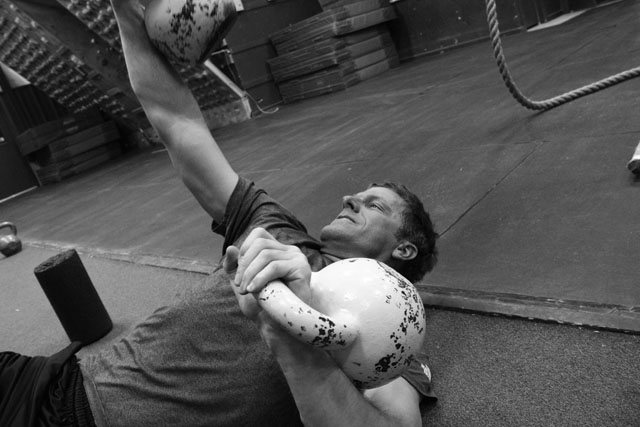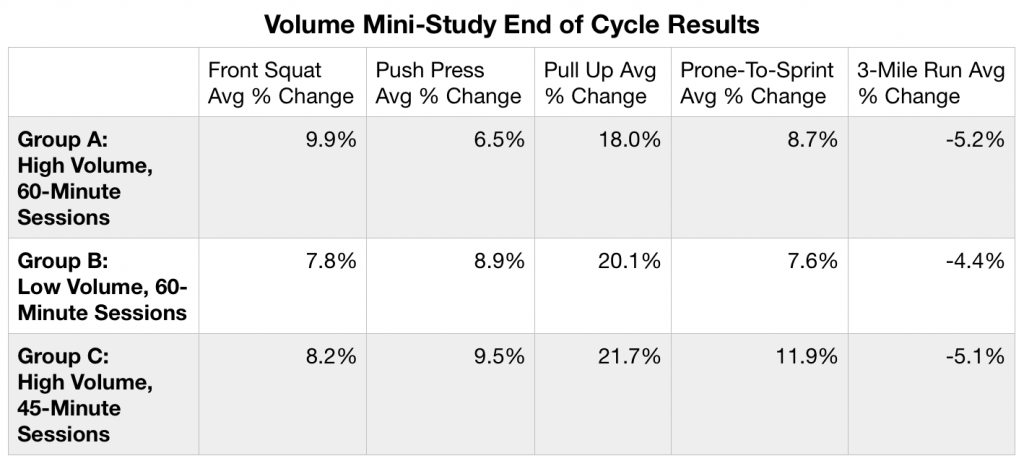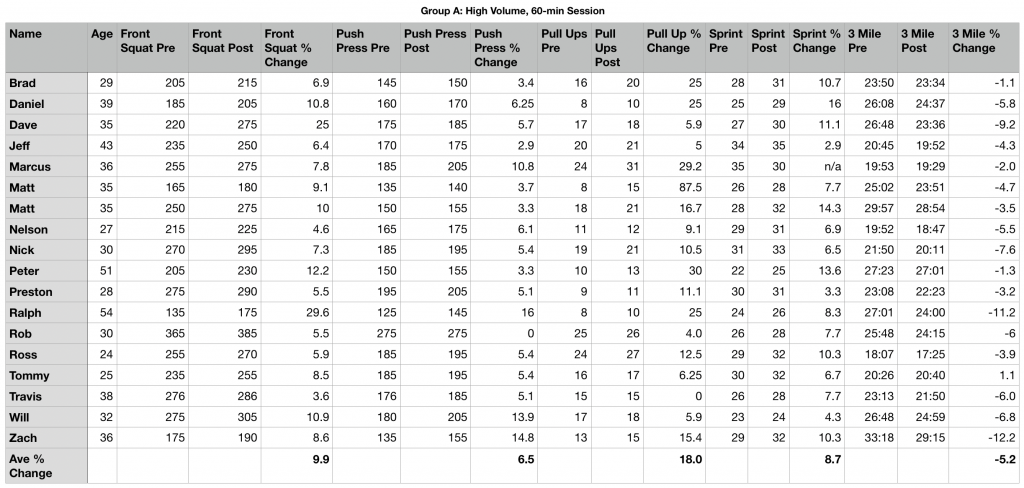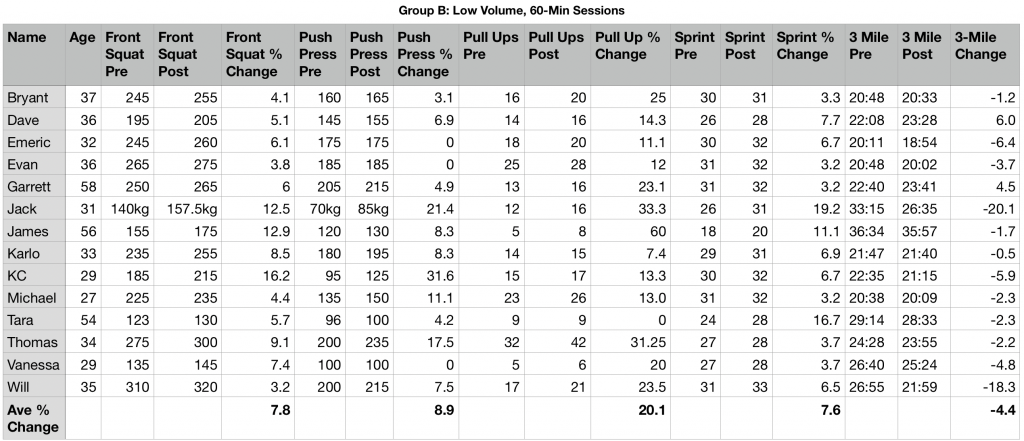By Rob Shaul, Founder
BLUF
Fewer and shorter (45-minute) training sessions achieved similar results for strength, work capacity, and endurance improvement as more and longer (60-minute) training sessions.
We conducted a 4-week Mini-Study using remote lab rats to test the effect of training volume across three training measurables: Strength (barbell and bodyweight), Sprint-Based Work Capacity, and Endurance (3-Mile run Performance).
Three different Lab Rat Groups (A, B & C) Completed the Study. Groups A and B completed the study in October/November, 2019, and Group C completed the study in August/September, 2020.
Group A: High Volume, 60-Minute Sessions – These Lab Rats trained 5 days/week, 60-Minute Training Sessions
Group B: Low Volume, 60-Minute Sessions – These Lab Rats trained 4 days/week, 60 Minute Training Sessions. Overall, this group completed approximately 2/3 the total volume of Group A
Group C: High Volume, 45-Minute Sessions – These Lab Rats trained 5 days/week, 45-Minute Training Sessions. The warm up and set/rep schemes for the strength work were manipulated to shorten the session duration.
Each group completed the same progression methodologies for the strength, work capacity, and endurance work. This wasn’t a study comparing different progression methodologies, but rather testing differences in training volume using the same progressions.
Specifically, we were interested to see if we could reach the same or similar strength and conditioning results by training (1) 2/3 of the total volume; and (2) shorter training sessions for Strength, Work Capacity, and Endurance.
Results
All 3 groups saw similar improvement over all the measured variables, indicating that the lower volume training protocol (Group B) and shorter training sessions (Group C) were as effective at improving fitness in a multi-modal training program as a higher volume, longer training session (Group A) programming.
See the chart below:
Background
MTI’s strength and conditioning research is focused on delivering actionable results to improve mission-direct program design.
The aim of this study was to test if a multi-modal training protocol with (1) 1/3 less overall training volume; and (1) shorter training sessions were as effective at increasing fitness across multiple variables as a higher-volume, longer training session program.
From a programming perspective, reducing training volume, and/or training session duration, without negatively affecting fitness improvement is a win/win. The athlete can achieve the same fitness with less time spent training, and less impact from training to the body.
Mini-Study Design/Deployment
Data collection for this Mini-Study was conducted in October/November 2019 and August/September 2020.
A 4-week cycle was designed to test the study questions above, and MTI advertised for Lab Rats via our weekly newsletter, Beta, which has 35,000+ weekly subscribers for both periods.
The October/November 2019 Lab Rat volunteers were randomly divided into two groups, A and B, and given access to the individual group programming. Both Groups began their cycles with a Monday 1RM Strength Assessment plus a work capacity assessment, and a Tuesday 3-mile run assessment, which were repeated 4 weeks later.
The August/September 2020 Lab Rats were all put into Group C and given access to the programming. Like Groups A & B, the Group C lab rats began their cycle with a Monday 1RM Strength Assessment plus a work capacity assessment, and a Tuesday 3-mile run assessment, which were repeated 4 weeks later.
Study subjects self-reported their pre and post cycle assessment results.
For Groups A & B, the differences in strength and work capacity training volume between the two groups was achieved by manipulating the number of strength/work capacity sessions each group trained. For Group C, the differences in strength and work capacity volume was achieved by manipulating warm ups and strength set/rep schemes to shorten the sessions from 60 minutes to 45 minutes:
- The high volume, long session (60-minute), Group A, trained 5 days/week and completed 10x total, 60-minute strength/work capacity training sessions including the initial assessment.
- The low volume group, Group B, trained 4 days/week and completed 7x total strength/work capacity training sessions including the initial assessment.
- The high volume, short session (45-minute), Group C, trained 5 days/week and completed 10x total, 45-minute strength/work capacity training sessions including the initial assessment.
The differences in endurance training volume was achieved by manipulating the number of 1-mile threshold intervals each group completed during the training cycle:
- Group A completed 15x total 1-mile threshold Intervals.
- Group B completed 10x total 1-mile threshold intervals.
- Group C completed 10x total, 1-mile threshold intervals.
The progression methodologies used to train barbell strength (front squat, push press), bodyweight strength (pull ups), work capacity (prone to sprint assessment), and endurance (3-mile run) were the same for each group.
Results and Discussion
A total of 41 individuals completed the entire training cycle, 18 in Group A (high volume, 60-min), 14 in Group B (low volume) and 9 in Group C (High Volume, 45-min). Below are the individual lab rat results.
For Group C above, you’ll see the second Matt’s 3-mile run time increased. Based on our questioning with him, we feel this was an anomaly and did not average his post-test percent change into the overall Group C average percent change for the 3-mile run.
The ability to achieve the same fitness improvements while completing 1/3 less overall training volume or shorter sessions (45-minutes) is a win/win for the athlete. He or she has to dedicate less time to fitness training, and the lower volume decreases the impact on the athlete’s body in the short and long term.
Next Steps?
We were somewhat surprised and encouraged by this mini-study result. We wrote up the results of the October/November comparison between Group A & B in a previous Mini-Study and were excited to see if shorter training sessions (Group C) would have had the same results.
The natural evolution of MTI programming has been towards overall simplification and a subtle but steady decrease overall training volume. The results of this study will intensify and accelerate that evolution.
Already, for several cycles, we’ve deployed shorter (45-minute) training sessions for MTI’s Daily Operator Sessions, and the limited lab rat programming we’ve been able to conduct at our Jackson Facility during the pandemic have also deployed 40-50 minute training sessions.
Next, were considering testing a 4-day/week program (like Group B) but with 45-minute sessions (like Group C) to see how far we can push efficiency. At some point, training improvement will be impacted by less training. There are no short cuts.
Moving ahead, we’ll consider decreasing volume through either shorter, or few training sessions for MTI’s Base Fitness programming for the mountain and tactical athletes we serve.
Questions, Feedback, Comments? Email rob@mtntactical.com
You Might Also Like Mini Study Results: 2/3 the Volume Programming Achieves the Same Fitness Improvements as a High Volume Programming for a Multi-Modal Training Cycle






